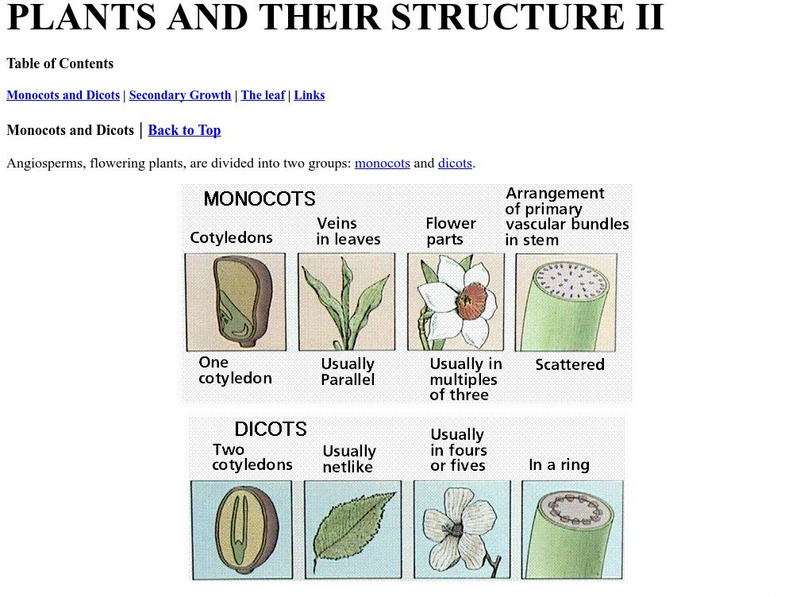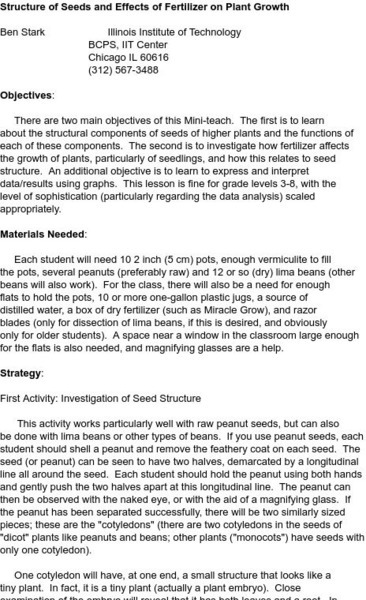Curated OER
The Plant Food Factory
Plants need sun and water to survive. Let kids discover these facts by reading a block of informational text and considering a scientific quandary. They read the text, then use the information to complete a two-part question about plant...
Curated OER
A Botanists View
Students explore plant and seed structure. They dissect a seed and identify its parts. In addition, they explain the function and compare and contrast monocotyledon and dicotlyledons.
Curated OER
Plant Propagation
Students successfully start a new plant by any means of vegetative propagation. They select a propagation method which is appropriate for the plant and keep a laboratory journal of the treatment and progress of the new plant.
Curated OER
Look at Those Seeds Grow!
Students explore plant science by participating in a botany activity. In this seed growth lesson, students identify the necessary elements to ensure a plant grows well and prepare seeds for planting. Students plant their soaked seeds in...
Curated OER
The Effects of Environment on Plant Growth: Selecting Seeds for Survival on a New Planet
Fifth graders conduct experiments to compare seed germination and plant growth rates. They construct a hydroponic plant unit and a lighthouse. They care for the plants for a month and collect data for graphs. They write a report.
Curated OER
Germinating Seeds on Gelatin
Students germinate seeds in unflavored gelatin to which liquid house plant food has been added. Students observe and record plant growth in this medium with a variety of variables in a number of experiments.
Curated OER
Vegetative Propagation Project
Students, in this project, successfully start new plants by various means of vegetative propagation.
Curated OER
Sunlight Necklaces
Third graders review the placement and role of the sun in the solar system. Using beads, they create a necklace which they can use to identify the amount of sunlight is being illuminated. In groups, they record observations on the...
Curated OER
Time Lapse Seed Germination with the QX3 Intel Digital Microscope
Students use the time-lapse feature of the QX3 Intel Digital Microscope
to observe germination of seeds. They use the QX3 Intel Digital microscope to create time lapse video films of seed germination experiments.
Scholastic
Scholastic: Study Jams! Science: Plants: Angiosperms: Seeds in Fruit
A video and a 7-question multiple-choice quiz on the topic of angiosperms, plants that produce seeds in fruit.
Estrella Mountain Community College
Online Biology Book: Plants and Their Structure Ii
Find out about the major differences between monocot and dicot plants. Learn about the many plant tissues which contribute to its growth.
Estrella Mountain Community College
Estrella Mountain Community College: Plants and Their Structure Ii
Explore information about the structure of the plant with this page. Investigate the difference between monocots and dicots by comparing both descriptions and pictures. Also understand what produces secondary growth. Finally, look at the...
BiologyWise
Biology Wise: Monocot vs. Dicot
One way plants have been classified has been based on the number of cotyledons in the seeds. The differences between monocots and dicots are listed along with some helpful facts.
Mocomi & Anibrain Digital Technologies
Mocomi: Classification of Plants
Discover how plants are classified and the main groups. Find out the difference between monocot and dicot plants with examples.
Science Education Resource Center at Carleton College
Serc: Investigating Local Plant Growth: Structures and Functions
In this biology lab, young scholars investigate structures and functions of local plants. Students will include a detailed drawing of their particular plant with labels and include functions of each of the plant structures.
Science and Mathematics Initiative for Learning Enhancement (SMILE)
Smile: Structure of Seeds and Effects of Fertilizer on Plants
In this lesson plan, young scholars identify parts of seeds and the effect of fertilizer on their germination and development.
Alabama Learning Exchange
Alex: Picture This!
This lesson plan involves capturing pictures and identifying monocots and dicots. Students will take pictures of plants and tell whether and why they are monocots or dicots. They will site characteristics of monocots and dicots to...
Alabama Learning Exchange
Alex: Botany Scavenger Hunt Where's the Ginkgo?
Students use a science nature journal to log in plants native to Alabama. They sketch pictures of leaves, identify the special characteristics of the plant, and describe the environment where it was found. They also research special...
Other
Perspective: The Plant Kingdom
Did you know their are about 270,000 plant species? This webpage investigates the phyla of the plant kingdom. Learn how plants are classified based on their tissue structure, seed structure, and stature. Each division is described with...

















